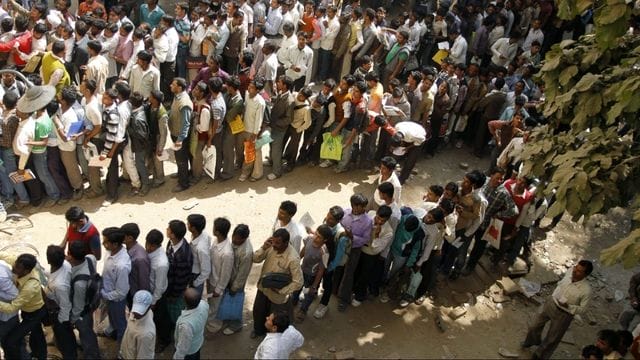The unemployment rate for people aged 15 and up in urban areas fell to 7.2% in July-September 2022, down from 9.8% the previous year, according to the National Statistical Office (NSO) on Thursday.
The country’s unemployment rate was high from July to September 2021, owing primarily to the crippling impact of Covid-related restrictions. The percentage of unemployed people in the labour force is defined as the unemployment rate.
The most recent data, based on a periodic labour force survey, show a decrease in the unemployment rate alongside an improved labour force participation ratio. The urban unemployment rate for people aged 15 and up was 7.6 per cent in April-June 2022, according to the 16th Periodic Labour Force Survey (PLFS).
It showed that the unemployment rate for women 15 and older in urban areas dropped from 11.6% a year earlier to 9.4% in July-September 2022. In April-June 2022, it was 9.5%. In urban areas, the unemployment rate for men dropped from 9.3% a year earlier to 6.6% in July-September 2022. In April–June 2022, it was 7.1%.
In the July-September quarter of 2022, the labour force participation rate in CWS (Current Weekly Status) for people aged 15 and up in urban areas rose from 46.9% to 47.9%. This was a change from the same time last year when it was 46.9%. In April–June 2022, it was 47.5%.
The Labour force is the part of the population that provides or offers to provide labour for economic activities that produce goods and services. This includes both people who are working and people who are looking for work.
In April 2017, NSO started PLFS. Based on the PLFS, a quarterly bulletin is put out with estimates of labour force indicators like the unemployment rate, the Worker Population Ratio (WPR), the Labor Force Participation Rate (LFPR), and the distribution of workers by broad status in employment and industry of work in the CWS.
Estimates of the number of unemployed people in the CWS give an average picture of how many people were out of work in a short period of seven days during the survey period.
In the CWS method, a person is considered unemployed if he or she did not work for at least one hour on any day of the week but looked for or was available for work for at least one hour on any day during the period.
CWS says that the number of people who were either working or not working on average in the week before the survey date is the labour force. LFPR is the number of people who are in the workforce as a percentage of the total population.
Between July and September 2022, the WPR (in per cent) for CWS in urban areas for people aged 15 and older rose from 42.3 per cent to 44.5 per cent. In April–June 2022, it was 43.9%. There have already been 15 Quarterly Bulletins of PLFS, one for each quarter ending from December 2018 to June 2022. This is the sixteenth Quarterly Bulletin for the period of July to September 2022.




Comments are closed, but trackbacks and pingbacks are open.